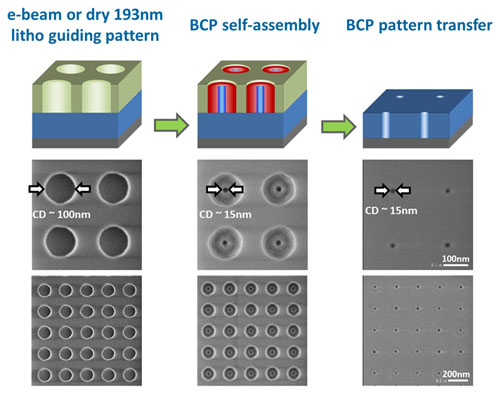Block Copolymer Lithography: Patterning at the Nanoscale
What is Block Copolymer Lithography?
Block copolymer lithography is a nanofabrication technique that utilizes the self-assembly properties of block copolymers to create ordered nanostructures. Block copolymers consist of two or more chemically distinct polymer chains covalently bonded together. When these polymers are annealed under specific conditions, they spontaneously self-assemble into periodic nanodomains, forming patterns such as lamellae, cylinders, or spheres. These nanopatterns can then be used as templates for the fabrication of functional nanostructures.

Advantages of Block Copolymer Lithography
Block copolymer lithography offers several advantages over conventional lithography techniques:
- High Resolution: Block copolymer lithography enables the fabrication of nanostructures with feature sizes down to sub-10 nm, surpassing the resolution limits of traditional photolithography.
- Cost-Effectiveness: Compared to advanced lithography techniques such as electron beam lithography, block copolymer lithography is more cost-effective and scalable. It does not require expensive equipment and can be performed using simple processing steps.
- Large-Area Patterning: Block copolymer self-assembly can be induced over large areas, enabling the fabrication of nanostructures across wafer-scale substrates. This makes it suitable for high-throughput manufacturing.
- Versatility: Block copolymer lithography can be used to create a wide range of nanostructures, including nanodots, nanowires, and nanopores. The morphology and dimensions of the nanostructures can be controlled by tuning the block copolymer composition, molecular weight, and processing conditions.
Types of Block Copolymers
Various types of block copolymers have been explored for nanolithography, each with unique self-assembly behavior:
- Diblock Copolymers: Diblock copolymers consist of two distinct polymer blocks and are the most commonly used type in block copolymer lithography. Examples include polystyrene-block-poly(methyl methacrylate) (PS-b-PMMA) and polystyrene-block-polydimethylsiloxane (PS-b-PDMS).
- Triblock Copolymers: Triblock copolymers contain three distinct polymer blocks and can form more complex nanostructures compared to diblock copolymers. Examples include polystyrene-block-polybutadiene-block-polystyrene (PS-b-PB-b-PS) and polystyrene-block-poly(2-vinylpyridine)-block-poly(ethylene oxide) (PS-b-P2VP-b-PEO).
- Multiblock Copolymers: Multiblock copolymers consist of more than three polymer blocks and offer even greater structural diversity. They can self-assemble into hierarchical nanostructures with multiple length scales.
Processing Steps
Block copolymer lithography typically involves the following processing steps:
- Substrate Preparation: The substrate surface is treated to control the orientation and alignment of the block copolymer domains. This can be achieved through surface functionalization, graphoepitaxy, or chemoepitaxy.
- Block Copolymer Deposition: The block copolymer is deposited onto the substrate, typically by spin-coating from a solution. The thickness of the block copolymer film is controlled by the spin speed and solution concentration.
- Annealing: The block copolymer film is annealed, either thermally or using solvent vapor, to induce self-assembly into ordered nanodomains. The annealing conditions, such as temperature and time, are optimized for the specific block copolymer system.
- Pattern Transfer: The self-assembled block copolymer nanopattern is transferred to the underlying substrate or functional materials. This can be achieved through selective etching, where one block is removed while the other acts as an etch mask, or through selective deposition of materials into the nanoscale templates.
Applications of Block Copolymer Lithography
Block copolymer lithography has found applications in various fields, leveraging its ability to create ordered nanostructures:
Nanoelectronics
Block copolymer lithography has been explored for the fabrication of high-density nanoscale patterns for semiconductor devices, such as transistors, memory devices, and interconnects. The self-assembled nanopatterns can be used as etch masks or templates for the deposition of functional materials, enabling the miniaturization of electronic components. For example, block copolymer lithography has enabled the creation of high-density memory arrays in computer chips, offering the potential for increased storage capacity and reduced power consumption.
Photonics and Plasmonics
Block copolymer lithography has been employed to create ordered arrays of metallic nanostructures for photonic and plasmonic applications. By selectively depositing metals into the self-assembled block copolymer templates, nanoscale gratings, nanodots, and nanoholes can be fabricated. These nanostructures exhibit unique optical properties and have potential applications in sensing, imaging, and light manipulation.
Membranes and Filtration
Block copolymer lithography has been used to fabricate nanoporous membranes with well-defined pore sizes and high pore densities. The self-assembled block copolymer nanodomains serve as templates for the creation of nanopores, which can be used for ultrafiltration, nanofiltration, and molecular separation applications.
Cutting-Edge Research and Future Perspectives
Current research in block copolymer lithography focuses on pushing the boundaries of nanopatterning capabilities and exploring new applications. One area of interest is the development of three-dimensional (3D) nanostructures using block copolymer self-assembly. By controlling the orientation and stacking of block copolymer domains, intricate 3D architectures can be created, offering new opportunities for the fabrication of advanced nanomaterials and devices.
Another promising direction is the integration of block copolymer lithography with other nanofabrication techniques to create hybrid patterning approaches. For example, the combination of block copolymer self-assembly with nanoimprint lithography or directed self-assembly methods can enable the creation of complex nanopatterns with precise alignment and registration over large areas. These hybrid techniques have the potential to overcome the limitations of individual patterning methods and enable the fabrication of novel nanostructures with enhanced functionality.
Despite the significant progress in block copolymer lithography, several challenges need to be addressed for its widespread adoption in industrial manufacturing. One of the main challenges is the precise control over the orientation and long-range order of the self-assembled nanodomains. Defects and grain boundaries can occur during the self-assembly process, limiting the pattern fidelity and uniformity over large areas. Ongoing research aims to develop advanced block copolymer architectures and processing strategies to improve the self-assembly behavior and minimize defects.
As block copolymer lithography continues to evolve, it is expected to play an increasingly important role in the fabrication of next-generation nanoscale devices and materials. The ability to create ordered nanostructures with high resolution, cost-effectiveness, and versatility makes block copolymer lithography a promising tool for advancing various fields, including nanoelectronics, photonics, energy storage, and biotechnology.
Further Reading
Frontiers in Nanotechnology, Fabrication of Nanodevices Through Block Copolymer Self-Assembly
Nanotechnology, Thin film block copolymer self-assembly for nanophotonics
